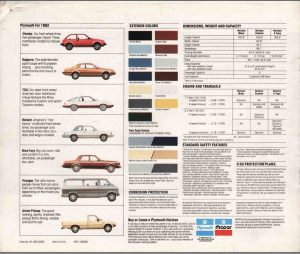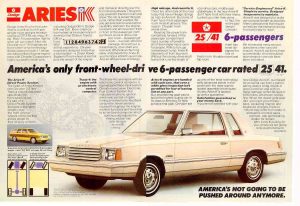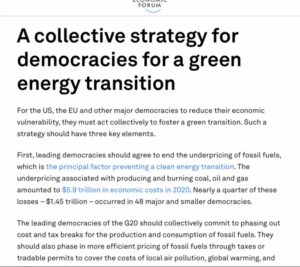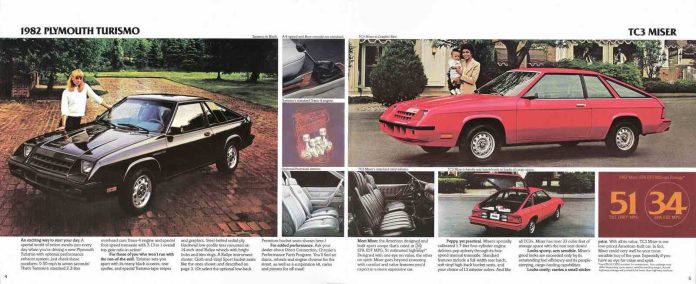A way to show how little the government actually cares about gas mileage is to look at the gas mileage cars used to get – forty years ago.
In 1982, you could buy a car like the Plymouth Horizon TC3 “Miser” that got 51 MPG on the highway and 34 MPG in the city. The former number is much higher than the highest highway mileage number of any new car that isn’t a hybrid car – which isn’t a fair comparison because a hybrid needs two drivetrains (one gas, one electric) to beat the highway mileage of the ’82 Plymouth.
And of course, you pay extra for that.
The new Prius – which is a fine car, by the way – stickers for $27,450. That’s what you’ll have to spend to get a new car that can deliver 56 MPG on the highway. That’s 5 miles-per-gallon better than the ’82 Plymouth delivered. But the ’82 Plymouth only cost $5,499 back in ’82 – which “inflation adjusts” (meaning, how much the buying power of the currency we’re forced to use by the central banking cartel that makes money by devaluing the buying power of fiat currency has diminished since then) to just over $17,000 in today’s money.
Thus, it costs about $10,000 more today to get 56 MPG than it cost to get 51 MPG forty years ago.
You are, accordingly, not saving anything.
Granted, the Prius is not the spartan car the ’82 Plymouth was. The Prius comes standard with AC and an automatic (CVT) transmission, power windows, locks and cruise control – all of the latter considered luxury amenities 40 years ago – as well as a very good stereo.
ut is also a heavy car – weighing in at 3,097 lbs. empty.
The ’82 Plymouth weighed 2,300 lbs. – the difference being equivalent to dumping a fully dressed (all accessories installed) big block (and cast iron) V8 engine from the ’60s in the Prius’ trunk.
It would be fascinating – Mr. Spock voice – to see what the effect of doing that would be on the mileage of the new Prius.
We can see, in a way – by referring to the mileage achieved by the ’82 Plymouth. And it almost certainly would have achieved even more than it did, if it had had the advantage of an overdrive transmission, which it didn’t have.
The Horizon TC3 came with a four speed manual transmission – no overdrive gearing – which meant its 1.7 liter engine (which was significantly smaller than the 2.0 liter engine in the 2023 Prius) was revving much faster at highway speeds than the Prius’ engine. The difference at 65 MPH was probably at least 1,000 RPM higher in the Plymouth than the Prius.
This alone would have a huge effect on mileage – and you can see how much by moving the gear selector in whatever you’re driving now from “Drive” to one notch lower (or by using the manual/paddle shifters many modern cars have) to get the overdrive transmission out of overdrive and into the equivalent of fourth gear (1:1 ratio). Typically, that would be fourth – in a car with a six speed automatic.
See the effect doing this has on how far your car will go on a gallon.
It would be . . . fascinating to see what the effect of installing a modern five or six speed automatic with just one overdrive gear (many modern automatics have two or three overdrive gears) would be on the Miser’s mileage. It would almost certainly be higher than the mileage achieved by the current Prius – and without costing $10,000 more to achieve it.
But the broader point isn’t how high the Miser’s mileage was. It is that higher mileage cars existed 40-plus years ago. This begs an important question: If the government is so mightily “concerned” about fuel efficiency – as it constantly insists it is – then why does it not encourage the manufacture of new cars like that old Plymouth (and there were many others like it, 40-plus years ago)?
There is a reason why the new Prius – which, like the old Plymouth, is a compact-sized car – weighs almost as much as mid-sized cars used to. And that reason is – wait for it! – the government. The very government that insists it is very “concerned” about reducing the amount of gas new cars use is directly responsible for how heavy new cars are. It would not be possible – it would not be legal – to sell a car like the ’82 Plymouth today because it does not comply with the government’s litany of regulations pertaining to all sorts of things that are at cross-purposes with fuel economy.
The ’82 had no air bags – and didn’t need to be designed around them. It was therefore possible to install a simple dashboard/door panels that weighed next to nothing. As did the car’s shell, which didn’t have to withstand head-on/rear-end and side-impact battering ram tests in order to be decreed “safe” to drive. If you ran the ’82 Plymouth into a a bridge abutment, it wouldn’t hold up as well as a new Prius. But that doesn’t mean the ’82 was more likely to crash into the bridge abutment and if you avoided such “accidents” – most of which are the result of driver error – you got to drive a car that could go 50-plus miles on a gallon of gas that cost $10,000 less in real terms than a new Prius.
But you can’t buy a car like the ’82 Plymouth today – which shows exactly how disingenuous the government’s bleatings about “fuel efficiency” really are.
In fact, the government is concerned with making cars cost more, so as to discourage people from driving them. That is what it is all about – with the latest excuse toward that end being all the bleating about the “climate” “changing.”
Instead of a Prius that costs $27,000 that goes 56 highway miles on a gallon of gas, how about a $50,000 electric car that goes a lot less far (a Prius can travel in excess 600 miles on 11 gallons of gas) and – if you can’t keep it constantly plugged in – makes you drive a lot less?
And there you go.
. . .
If you like what you’ve found here please consider supporting EPautos.
We depend on you to keep the wheels turning!
Our donate button is here.
If you prefer not to use PayPal, our mailing address is:
EPautos
721 Hummingbird Lane SE
Copper Hill, VA 24079
PS: Get an EPautos magnet or sticker or coaster in return for a $20 or more one-time donation or a $10 or more monthly recurring donation. (Please be sure to tell us you want a magnet or sticker or coaster – and also, provide an address, so we know where to mail the thing!)
My eBook about car buying (new and used) is also available for your favorite price – free! Click here. If that fails, email me at EPeters952@yahoo.com and I will send you a copy directly!













I had a 1981 Toyota Starlet. Before I put wider tires on it for better high speed stability, I got 44 mpg highway at 70 mph. City mileage was around 33 mpg. It had a 1.3L with a smog controlled carb. Imagine if you could make that thing run without the bullshit emissions plumbing. High efficiency cars should have been exempt from CAA standards
Ford announces doorbuster sale on Mach-Eeeeees!
‘Ford will lower pricing of the Mach-E, which is comparable to Tesla’s Model Y, by an average of about $4,500, depending on the model.
‘Price cuts will mean that not all Mach-E models, based on the trim, will be profitable on a per-unit basis.
‘The Mach-E’s starting price will now range from about $46,000 to $64,000. Tesla’s Model Y starts at about $53,500 to $57,000, without any options.’
https://www.cnbc.com/2023/01/30/ford-mustang-mach-e-price-cut.html
Desperation, as recession sets in? Or Henry Ford’s strategy all over again, of steadily cutting prices on the Model T as production ramped up?
Fact is, the car biz is in trouble. Repos are booming. EeeVees are still too damned expensive. And I reckon it’s gonna get a lot worse.
Hi Jim,
Yup.
I’ve been saying for some time that it’s not EVs, per se, that are problematic. The problem is that there are only so many people who can afford to spend even $35k on a new car, regardless of its drive type. That figure amounts to about half of the average two-earner/family income in this country. When you factor in the taxes/insurance, it is a grossly unsupportable financial burden for most people.
And yet, the average transaction price of new cars is now more than $40,000.
It cannot last.
Eric,
GM reports earnings tomorrow; Ford on Thursday. Then they will conduct conference calls for Wall Street anal-cysts … sorry, ‘analysts.’
We’ll see how things are workin’ out for them, and their growing EeeVee businesses.
The drive to higher mileage was mostly driven by the cost of driving. In spite of the fact that fuel consumption is a fraction of the cost of driving a car, and has been for many years/decades. Back in the ’80s, when I claimed my driving expenses on my tax return, the IRS gave a standard allowance in lieu of accurate records, of 50 cents per mile. which means it cost more than that (the IRS doesn’t give anything away). Gas was around a buck a gallon, and given an average of 20 mpg, that means fuel cost for driving one mile was 5 cents. Which left 45 cents per mile to other things, like depreciation, insurance, taxes, etc. Doubling the cost of fuel would only cost 10 cents per mile.
“The drive to higher mileage was mostly driven by the cost of driving”
Now, not so much.
Hi John, and it’s currently only 65c/mi. Not nearly enough based on the new inflationary pressures for everything. My salesman are starting to suffer. The premise remains the same though, that we (the company) wants to pay for the use of your car for business, period, no more, but certainly not less.
So we are going to supplement them.
But what about the average company that doesn’t or won’t. Employees will lose money driving their own car for biz. Hopefully they figure that out themselves and adjust as needed.
Isn’t it curious that to promote “safety” we end up with heavier cars which reduce safety. Simple physics. The more mass involved in a collision the greater the damage will be. As with all things mechanical, there is a limit to what can be done to solve a particular problem. More power to increase performance adds weight that reduces performance. The only thing preventing putting a thousand pound thousand horsepower engine in a car, is the added weight, which would reduce performance. Add weight to increase safety is only effective up to a point, where adding weight may have a positive influence in one regard, has a negative influence on another. I think we passed that point some time ago.
It’s called the law of diminishing return.
Banning ice powered vehicles to be replaced with EV’s that use twice as much fuel (20.8 mpg), = insanity.
This is what test driver’s of EV’s get in the real world….
travelling 100 miles in an average EV uses 1.20 gallons equivalent of fuel = 41.66 kwh of electricity that is the net amount, but….at the power plant 4.80 gallons of fuel were burnt to get a net 1.20 gallon of fuel equivalent 41.66 kwh used by the EV.
travelling 100 miles in an average EV uses 1.20 gallons equivalent of fuel = 41.66 kwh of electricity @ $0.40 per kwh = $16.66, back at the power plant 4.80 gallons were burnt to get the net 41.66 kwh of electricity. NOTE: 4.80 gallons were burnt to go 100 miles. = 20.8 mpg
There is an additional cost for the EV owner: the tesla $22,000 battery is used up, worn out in 100,000 miles. this works out to $22.00 per 100 miles it is costing you for the battery. Total cost: $16.66 plus $22.00 = $38.66
EV owner uses 4.80 gallons to go 100 miles, that is 20.8 mpg, lots of ice cars get better fuel economy.
travelling 100 miles in a 50 mpg diesel uses 2 gallons of fuel @ $4.00 per gallon = $8.00 and it has a huge range……
Should be still selling these:
ATTENTION: the 2014 Volkswagen Golf BlueMotion diesel, capable of a claimed 88.3 mpg imperial, or 73.5 mpg U.S…..1.36 gallons for 100 miles…… it has a 971 mile range, the perfect car.
should be driving these high mpg ice diesel cars:
Model HP Avg. cons l/100km mpg U.S.
Fiat 500 1.3 JTD Multijet 16V Pop DPF 75 4.2 56
VW Golf 1.6 TDI BlueMotion DPF 105 4.1 57
Skoda Fabia 1.4 TDI GreenLine DPF 80 4.1 57
Opel Corsa 1.3 CDTI ecoFlex CO2 Pack DPF 75 4.1 57
Audi A3 1.6 TDI Attraction DPF 105 4.1 57
Toyota iQ 1.4 D-4D DPF 90 4.0 59
Renault Twingo 1.5 dCi Rip Curl 84 4.0 59
Volvo S40 / V50 1.6D DRIVe Start/Stop DPF 109 3.9 60
Volvo C30 1.6D DRIVe Start/Stop DPF 109 3.9 60
Toyota Prius 1.8 Hybrid 136 3.9 60
Mini One D DPF 90 3.9 60
VW Polo 1.6 TDI BlueMotion 90 3.7 64
Seat Ibiza 1.4 TDI Ecomotive DPF 80 3.7 64
Ford Fiesta 1.6 TDCi ECOnetic DPF 90 3.7 64
smart fortwo coupé 0.8 cdi pure softip DPF 54 3.4 69
VW made a lightweight diesel hybrid that got almost 300 mpg, that was a better solution then EV’s, that get 20.8 mpg…lol….
The XL1 weighed 1750 lb….lightness matters….get this for commuting and a 1200 lb. Super 7 for weekends….
Volkswagen XL1 Diesel-Hybrid 300 mpg highway…
https://www.hotcars.com/remembering-the-1liter-supercar/
There was ANOTHER EV that spontaneously erupted, this time in California, and it required about 6,000 gallons of water to put the fire out. And to think, those psychopaths want to SHOVE EVs down the masses’ throats under guise of “Climate change”…
http://www.wnd.com/2023/01/watch-ev-spontaneously-erupts-california-freeway-took-6000-gallons-water-put/
The biggest problem with EV’s is the batteries in EV’s are very dangerous, a fire hazard, how they ever got passed for safety standards is a huge mystery.
What happens when 2200 Ev’s (a new complex in planning stage will have 2200 parking spaces)….imagine 2200 lithium fire bomb EV’s parked), are parked in underground parking at an apartment block or office tower and they catch fire? You can’t take propane into underground parking, but you can take a fire bomb lithium battery car underground.
Lithium-ion batteries have a tendency to overheat and can be damaged at high voltages leading to thermal runaway and combustion. like driving around sitting on top of a huge bomb, make sure you don’t hit anything or get hit while driving one of these abortions.
EV fires are very hard to put out the only way is with the application of huge amounts of water.
The self-immolation failure mode of Lithium Ion batteries has been known since their very beginning. The intense heat causes the battery to generate its own oxygen so trying to smother the fire doesn’t work.
Tactically, this may mean using a master stream, 2½-inch or multiple 1¾-inch fire lines, to suppress and cool the fire. Vehicle fires don’t typically call for surround-and-drown tactics, but these are not typical vehicle fires.
One example: the flames on the Tesla were extinguished, it reignited again. Firefighters began hosing it down with copious amounts of water, up to 200 gallons per minute, but “that did not extinguish the flames,” according to the NTSB. At approximately 9:13 p.m., nearly three hours after the first alarm was received, firefighters had to pour out more than 600 gallons of water per minute. In the end the agency used 20,000 gallons of water.
Then the fire still isn’t put out……..Batteries can be expected to reignite after being put out because they still have stored energy. 15 hours later it catches fire again…
“Battery fires can take up to 24 hours to extinguish”….. the vehicle must be parked under “quarantine” for 48 hours, so that no new fire can break out.
Batteries are difficult to extinguish, and they can burst into flames again several hours later –ATTENTION: in some cases, right up to a week later
Over heard a fireman say as he put one of these fires out,that he would never own one ,that’s good enough for me sir!never!
another huge problem….
– If there is a fire in an electric or hybrid car, we are acutely aware that the smoke may contain hydrogen fluoride, which is extremely harmful. Even small doses can result in water in the lungs.
The greater the amount of energy the electric vehicle may contain, the greater the fire risk of electric vehicle fires.
So they want to increase the range but that means bigger batteries which are far more dangerous, tesla is the worst they have up to 1800 lb of batteries, a huge fire on wheels going somewhere to happen.
Here is the biggest problem nobody talks about……
31% of fire departments don’t train for electric vehicle fires. 50% of fire departments say they don’t have special protocols in place to handle electric vehicles after an accident. These EV’s shouldn’t be sold the fire departments can’t even put out the fires, these things endanger everyone.
Remember this while driving your EV:
Drive down the road in your EV, hit some debris, a high bump, a huge pothole (the cities don’t fix the roads anymore, so don’t buy an EV), a raised manhole cover or drive into the ditch, puncture the battery and the battery catches fire.
In addition to crashes, some of the earlier fires involving Teslas were reportedly caused by debris in the roadway puncturing and gouging the undercarriage of the lithium-ion battery pack.
The damaged battery pack exposed the lithium, causing an exothermal reaction and subsequent fire. This hazard was thought to have been solved with the installation of a titanium cover encasing the battery pack, giving the undercarriage more resistance to severe damage. looks like they don’t work too well, remember this while driving your EV.
Most electric vehicle fires are caused by the thermal runaway of a damaged battery. Thermal runaway is the rapid and extreme rise in temperature and when it initiates the same reaction in adjacent cells it is known as ‘thermal runaway propagation. When thermal runaway happens, it can produce smoke, fire and even explosions.
Fires while the electric vehicle is stationary (an EV can catch fire even while parked, don’t sleep in it), this can happen from:
Extreme temperatures, both extreme heat and cold
High humidity
Flooding
Internal cell failure
ATTENTION: Overcharging or problems with the charging station (the EV can catch fire), don’t charge it in your garage, what if something goes wrong while charging?
Is that why so many charging stations are out of order? the software shuts them down over any little issue because they can cause fires.
Fast charging?…start a fire….lol
Extreme fast chargers, for example,can push battery pack temperatures to 270ºC/514ºF after just a few minutes of charging.
If you fast charge a lot, you wreck the battery, if you don’t…. you wait hours to charge….lol
Fires in gas powered vehicles is far easier to put out compared to an EV and doesn’t take 24 hours to put out. (it is very very difficult for a diesel powered vehicle to catch fire, they are by far the safest)
they soon will ban far safer gas powered vehicles and the best and the safest by far diesel powered vehicles, throw a match in diesel, it won’t even catch fire……..
After 10 years the battery in your EV is near dead, useless, the car is scrap now, no residual value: Lithium-ion batteries are subject to aging, losing capacity and fail frequently after a number of years.
A bigger worry is being cremated in the thing.
Electric car batteries are catching fire and that could be a big turnoff to buyers.
All the most important components in the new EV’s are all made in china. low quajity = fire risk.
BMW initiated a recall in the United States of 10 different BMW and Mini plug-in hybrid models because of a risk of fire caused by debris that may have gotten into battery cells during manufacturing.
Then, in early October, the National Highway Traffic Safety Administration opened an investigation into reports of apparently spontaneous battery fires in Chevrolet Bolt EVs.
A few days later, Hyundai announced that it was recalling 6,700 Kona Electric SUVs in the United States, among about 75,000 of that model to be recalled worldwide, after it had received numerous reports of vehicles catching fire while parked.
Tesla faced problems this last year after multiple highly publicized battery fires.
Container puts out inextinguishable fires in electric cars
https://cfpa-e.eu/container-puts-out-inextinguishable…/
Hi Anon,
Please – do me a favor – and don’t repost the same really long items; it’s fine to excerpt and (better) link to material already posted… thanks!
Afternoon all!
I had one of these, at least, the non-“Miser” version.
It was a 1982 Turismo completely pimped-out, special-ordered new. It had a belt-driven SOHC 2.2L four, 4-speed wide ratio transaxle with OD 4th, A/C, cruise, PB, PS, etc. Once broken in, it got 28 MPG on the highway doing 70 MPH. If for some reason I had to stay at 55 MPH, it got ~33 MPH. City mileage was in the mid- 20’s MPG, depending on time of year and how “stop” it was vice “go”. I had it for 22 years, though I did have to feed it a head gasket (stock fault of the early 2.2’s) and an A/C evaporator (stock fault of almost every MoPar with an aluminum evap). When I retrofitted a 5-speed A525 transaxle with closer ratios and O/D 5th, mileage got a little better in the city, but highway at 70 MPH was still ~28 MPH (same O/D ratio).
It was a really nice ride for 1982. I wish we had a lightweight option like this with an aluminum DOHC 2.0L four available.
I learned to drive in a 1979 Omni with a 1.7 L (65 HP) VW engine. 4 speed stick. No AC, no cruise, no rear defrost or wiper. Did have FM radio (not stereo). Pretty sure no passenger side mirror. Iacocca sold a s***load of them in my town. I mean you’d see several with identical paint jobs in the mall parking lot. As much of a POS as it was, still better than bike or bus.
I took driver education and passed my test in a Dodge Omni. Omnis and Horizons were everywhere even through the 1990s. They were driven by high school and college students, elders, rental fleets, government officials, you name it.
Then they all disappeared.
I drove a 61 Mercedes 190Db in high school, it could get 60mpg if driven gently. My Rabbit diesel pickup got about 50 day in and out. My Escort diesel hatchback also got around to 58. And the 76 Honda Civic I fixed up and sold got well over 40 on gas and was fun to scoot around in. My 59 Valiant with the little slant 6 gets about 37 on a highway at 60.
Getting good economy isn’t that hard or exotic. People mostly dont value it enough to buy it.
1982 built cars are considered the sweet spot in efficiency for mpg nerds. Apparently, after the oil shocks of the 1970s the auto companies finally got their high mpg cars on the sales lot, here is a link to the EPA MPG pamphlet for 1982:
https://afdc.energy.gov/files/pdfs/1982_feg.pdf
The first thing is notice that the DOE, with all it’s money and resources, produced a completely substandard replication online of their handout, which is barely readable. It looks like an office temp with a bad attitude was assigned to xeroxing it and putting it online.
Here is a more readable text file, but still sucks in presentation:
https://fueleconomy.gov/feg/download.shtml
https://fueleconomy.gov/feg/epadata/82guide.txt
The EPA fuel economy ratings from the early 1980s are higher than the EPA lists them now, take for instance the 1984 Honda CRX:
https://fueleconomy.gov/feg/epadata/84guide.txt
0HONDA
+_______________________
0 CIVIC COUPE $ 368 51 57 67 82(1300CC)/ 4
https://www.fueleconomy.gov/feg/PowerSearch.do?action=noform&year1=1984&year2=1984&make=Honda&model=Civic%20CRX&srchtyp=ymm
Old EPA rating 51 city 67 hwy
New EPA rating 38 47
1984 Honda Civic CRX Commercial
https://www.youtube.com/watch?v=RjVijd_E69U
——————-
Over in Europe they do sell cars with high fuel economy ratings, like the Toyota Aygo:
https://car-emissions.com/cars/model/toyota/aygo
A reason why 1982 was a sweet spot for gas mileage was because many 1982 cars were designed around 1979, the year the Iran hostage crisis, Iran-Iraq War, and the second energy crisis hit. At that time, car companies planned their products for the next 3-5 years under the very rational assumption that by the time they came out, gasoline would be selling for $2.50 a gallon or more. That never happened; in fact, gasoline prices stayed around $1-$1.50 a gallon for the next 15 years or so.
‘the government’s litany of regulations pertaining to all sorts of things that are at cross-purposes with fuel economy.’ — eric
‘As if there weren’t enough problems with EVs, now there are warnings about their heavy weight.’ — John B
‘[EeeVees], due to their huge batteries are even heavier, and thus use more energy, and get worse MPG.’ — Nunzio
Amen, y’all.
In two-vehicle collisions, crash safety also depends on their relative weights. If a 3,000-lb Prius is hit hard by a 6,000-lb F-250 crew-cab pickup — or even a 5,000 lb EeeVee — damage to the Prius will be catastrophic.
Big Gov piously mandates crash safety features, but is uninterested in growing extremes of weight and dimensions. The vertical mismatch between a high ground clearance pickup with towering hood and bed heights, versus a low-roofline sedan or sports car, almost guarantees overclimbing or underclimbing should the two accidentally collide.
Seems like in the ancient days of “5 mph bumpers,” regulators wanted consistent bumper heights. That’s all out the window today, as giant hulking pickups share the road with squat little econoboxes.
How typical of Big Gov: they regulate the sh*t out of trivial factors, but totally lose sight of the big picture. Low vehicle weight and hybrid power trains are a far better path to slashing fleet fuel consumption than heavy EeeVees requiring new infrastructure and materials supply chains, including big, ugly lithium and copper mines.
You can prod a recalcitrant mule with a 2×4 to the skull. But the only thing that makes Big Gov take notice is a nuclear mushroom cloud over the Capitol — not an all-bad idea, though I cautiously refrain from advocating it for now. 😉
As if there weren’t enough problems with EVs, now there are warnings about their heavy weight compared to traditional vehicles that run on gas…..
https://www.wnd.com/2023/01/heavy-warning-sounded-extra-weight-electric-vehicles
And now they want to ram EVs down our throats….which, due to their huge batteries are even heavier, and thus use more energy, and get worse MPG…in the name of saving energy/getting better MPGs- but it’s O-K, because few seem to notice, since we’re talking Kilowatt-hours vs. MPGs, so the inefficiency of the powerful and heavy EV gets lost in the translation to the average
JoeTyler, who seem to think that electricity is churned-out by antiseptic unicorns in a sterile environment along with “carbon credits” and lithium batteries…….Off topic
Gossip news says Israel has bombed Iran so this argument may be mute. Good ole Israel….Bomb a drone factory to keep Iran from making nukes. Yea,,, makes sense, right!
My take,,, Since Iran is making drones for Russia the good ole USA had Israel bomb the factory. The crazies are gonna kill all of us if their not taken down.
God I enjoy those retro reviews. So hilarious to see them judged in a contemporary light. “To prove its sporting chops, our test car did the 0-60 run in a brisk 9.2 seconds.” It’s effectively impossible to build a practical sub 3000 lb car now.
Wow, “Motorweek” is still on the air. Sadly, Goss’ Garage is no more since Pat Goss died, but John Davis is still hosting.
I assumed that “Motorweek” went the way of MPT’s “Wall Street Week” a couple of decades ago, with Davis being eased out like they tried with Lou Reukeyser.
It appears that the masses are finally waking up to the sinister Anti-God/ Anti-Human agenda being pushed by the WEF and want nothing to do with eating bugs, giving up any gas stoves or gas cars they own, being renters of everything, etc…..
https://thehighwire.com/videos/the-wef-falls-flat-in-davos/
FDR’s view of government was that it was a vehicle to make peoples’ lives better.
That is quite subjective.
Our overlords still have that view and will safety Nazi us to the point of driving pedal powered bubble wrap if allowed.
Dan,
No shit! People can figure out what makes their lives better all by themselves. Though some might not live by what they “figure out”, the state hasn’t a clue what does. What the state does have to is to what makes their lives better.
My second car after I got my license was a 1978 Olds Cutlass Supreme Brougham luxury package. It had a 260 V-8 2-barrel carburetor, automatic and 2.29 axle gearing. The car got better than 25 mpg highway. Better than a lot of midsizes today and simple to maintain and repair at home. I just hope the government doesn’t try to reinvent the wheel!
My ’92 Lincoln Town Car used to get 23MPG on the highway with the 4.6 V-8. I’m sure others got better, because I never get the MPG’s a vehicle is capable of….but that was the most fuel-efficient vehicle I’ve ever had.
Hi Allen,
The problem is that govco IS trying to reinvent the wheel, only their version would be square. They’re hell bent on replacing proven, abundant, reliable sources of energy like oil, natural gas, and nukes, with windmills and solar panels that are UNreliable, intermittent, and expensive. All for the nonexistent “climate change” hysteria.
The highway mileage test was different in 1982 under the 55 MPH speed limit, and there was a fudge factor involved depending on how generous the government wanted to be with the car. In the case of Chrysler, with Iacocca on the air every night in the commercials, more popular than many politicians, and the government holding loan guarantees, the EPA was no doubt generous.
Of course, Mayor Pete would like to return us to those days, but the fudge factor under a restored 55 MPH policy won’t be in the manufacturer’s favor.
Hi Roscoe,
That’s true, but I think the point stands. High-mileage cars were available. And they got very high mileage without all the “technology” of today. Imagine the mileage a 2,000 or so pound car with fuel injection and an overdrive transmission could deliver…
Sure, my ’85 Dodge Colt (Mitsubishi Mirage) got 47 highway.
My 83 Dodge Colt got up to 51 mpg on the highway, and frequently 39-41 in town.
Wasn’t it Tom Ogle that invented a device to replace the carburetor, that would have given us great gas mileage? I think Ogle conveniently ended up dead, along with his invention. Cannot have the oil companies having any competition. So this “concern” about gas mileage is BS theatre, so far as I can tell.
“Mayor Pete would like to return us to those days, but the fudge factor under a restored 55 MPH policy won’t be in the manufacturer’s favor.”
Roscoe, I’d rather not think of Mayor Pete’s “fudge factor” if you don’t mind…
Mayor Peter uses his peter as a dipstick to measure fudge factor depth.
Hmmm… interesting. I’ve never heard of or seen the Horizon Miser edition TC3 before. It either didn’t sell very well or, more likely, I just wasn’t paying attention to it back in 1982. Of course being a pre-driving age teenager then I was much more interested in muscle cars like my dad’s ’73 Mach 1 Mustang, which he sold out from under me before I got my license. Fuel economy be damned!
Hi Plymouth,
I had a high school buddy who owned a Champ – and much as we made fun of it (e.g., the Chump) it was really easy on gas. I remember because I was a broke teenager and none of us had any money to speak of. But we could afford to road trip in the Chump!
Twin-stick 4 speed. Had one 30 years ago as a beater myself
Probably depended where one lived, PlymouthBill. In the NY metro area, those Misers were all over the place. I’ll bet at the same time, one would never have seen so much as one here in rural KY!
Yeah, my sister who’s a year or two older than Eric had a relatively new one as her first car in ’81 in NJ. Great gas mileage when it was running, which was intermittent at best. Ugly pale yellow color, too.
Plymouthbill,
My dad sold a beautiful 69 Lemans in silver with black landau top with ralley rims right before I got my license and replaced it with the ford wagon with the fake wood on the side. Forgiveness is divine but I may have a chat with him someday beyond the pearly gates.
The truly pitiful part is that the Psychopaths In Charge could not care less about anyone’s safety except their own, but it is a useful excuse to demand submission. Same with the mask and the shot. After all, death is their preferred outcome. For you. Unless you contribute to political campaigns. A thing large corporations are well aware of.